Origin of Color and Spectral Characteristics of Nanhong Agate from Northeast Yunnan, China
Abstract
:1. Introduction
2. Materials and Methods
2.1. Sample Materials
2.2. Methods
3. Results and Discussion
3.1. Gemological Characteristics
3.2. Spectral Characteristics
3.2.1. Infrared Spectra
Diffuse Reflection
Transmission
3.2.2. UV–VIS Spectra
3.2.3. Raman Spectra
3.3. Microstructural Characteristics
3.4. Geochemical Characteristics
3.5. Trace Elements
3.6. Discussion
4. Conclusions
Author Contributions
Funding
Data Availability Statement
Acknowledgments
Conflicts of Interest
References
- Götze, J.; Möckel, R.; Pan, Y.M. Mineralogy, Geochemistry and Genesis of Agate—A Review. Minerals 2020, 10, 1037. [Google Scholar] [CrossRef]
- Moxon, T.; Palyanova, G. Agate Genesis: A Continuing Enigma. Minerals 2020, 10, 953. [Google Scholar] [CrossRef]
- Gotze, J.; Nasdala, L.; Kleeberg, R.; Wenzel, N. Occurrence and distribution of “moganite” in agate/chalcedony: A combined micro-Raman, Rietveld, and cathodoluminescence study. Contrib. Miner. Petr. 1998, 133, 96–105. [Google Scholar] [CrossRef]
- Moxon, T.; Ríos, S. Moganite and water content as a function of age in agate: An XRD and thermogravimetric study. Eur. J. Miner. 2004, 16, 269–278. [Google Scholar] [CrossRef]
- Svetova, E.N.; Palyanova, G.A.; Borovikov, A.A.; Posokhov, V.F.; Moroz, T.N. Mineralogy of Agates with Amethyst from the Tevinskoye Deposit (Northern Kamchatka, Russia). Minerals 2023, 13, 1051. [Google Scholar] [CrossRef]
- Svetova, E.N.; Svetov, S.A. Agates from Mesoproterozoic Volcanics (Pasha-Ladoga Basin, NW Russia): Characteristics and Proposed Origin. Minerals 2023, 13, 62. [Google Scholar] [CrossRef]
- Shen, M.M.; Lu, Z.Y.; He, X.M. Mineralogical and Geochemical Characteristics of Banded Agates from Placer Deposits: Implications for Agate Genesis. ACS Omega 2022, 7, 23858–23864. [Google Scholar] [CrossRef]
- Svetova, E.N.; Chazhengina, S.Y.; Stepanova, A.V.; Svetov, S.A. Black Agates from Paleoproterozoic Pillow Lavas (Onega Basin, Karelian Craton, NW Russia): Mineralogy and Proposed Origin. Minerals 2021, 11, 918. [Google Scholar] [CrossRef]
- Goetze, J.; Stanek, K.; Orozco, G.; Liesegang, M.; Mohr-Westheide, T. Occurrence and Distribution of Moganite and Opal-CT in Agates from Paleocene/Eocene Tuffs, El Picado (Cuba). Minerals 2021, 11, 531. [Google Scholar] [CrossRef]
- Svetova, E.N.; Svetov, S.A. Agates from Paleoproterozoic Volcanic Rocks of the Onega Structure, Central Karelia. Geol. Ore Depos. 2020, 62, 669–681. [Google Scholar] [CrossRef]
- Goldbaum, J.; Howard, C.; Rabinovitch, A. Spatial Chirp of Agate Bands. Minerals 2019, 9, 634. [Google Scholar] [CrossRef]
- Götze, J.; Berek, H.; Schäfer, K. Micro-structural phenomena in agate/chalcedony: Spiral growth. Miner. Mag. 2019, 83, 281–291. [Google Scholar] [CrossRef]
- Lorenzi, R.; Zullinow, A.; Gagliardi, V.; Prosperi, L.; Paleari, A.; Adamo, I. Atomic and microstructural origin of banded colours in purple-blue variety of agate from Yozgat Province, Turkey. Phys. Chem. Miner. 2022, 49, 33. [Google Scholar] [CrossRef]
- Conte, A.; Della Ventura, G.; Rondeau, B.; Romani, M.; Guidi, M.C.; La, C.; Napoleoni, C.; Lucci, F. Hydrothermal genesis and growth of the banded agates from the Allumiere-Tolfa volcanic district (Latium, Italy). Phys. Chem. Miner. 2022, 49, 39. [Google Scholar] [CrossRef]
- Natkaniec-Nowak, L.; Dumanska-Slowik, M.; Gawel, A.; Latkiewicz, A.; Kowalczyk-Szpyt, J.; Wolska, A.; Milovská, S.; Luptáková, J.; Ladon, K. Fire agate from the Deer Creek deposit (Arizona, USA)—New insights into structure and mineralogy. Miner. Mag. 2020, 84, 343–354. [Google Scholar] [CrossRef]
- Mrozik, M.; Götze, J.; Pan, Y.M.; Möckel, R. Mineralogy, Geochemistry, and Genesis of Agates from Chihuahua, Northern Mexico. Minerals 2023, 13, 687. [Google Scholar] [CrossRef]
- Zhou, Y.F.; Liu, Z.Y.; Zhao, Z.T.; Guo, Y. Quantitative Study on Colour and Spectral Characteristics of Beihong Agate. Minerals 2022, 12, 677. [Google Scholar] [CrossRef]
- Götze, J.; Möckel, R.; Kempe, U.; Kapitonov, I.; Vennemann, T. Characteristics and origin of agates in sedimentary rocks from the Dryhead area, Montana, USA. Miner. Mag. 2009, 73, 673–690. [Google Scholar]
- Götze, J.; Möckel, R.; Vennemann, T.; Müller, A. Origin and geochemistry of agates in Permian volcanic rocks of the Sub-Erzgebirge basin, Saxony (Germany). Chem. Geol. 2016, 428, 77–91. [Google Scholar] [CrossRef]
- Zhang, X.M.; Ji, L.; He, X.M. Gemological Characteristics and Origin of the Zhanguohong Agate from Beipiao, Liaoning Province, China: A Combined Microscopic, X-ray Diffraction, and Raman Spectroscopic Study. Minerals 2020, 10, 401. [Google Scholar] [CrossRef]
- Zhang, S.X.; Cui, L.; Guo, Q.F.; Li, N.; Liu, Y.; Rao, Y.H.; Liao, L.B. A Comparative Study on Gemological Characteristics and Color Formation Mechanism of Moqi Agate, Inner Mongolia Province, China. Crystals 2023, 13, 977. [Google Scholar] [CrossRef]
- Lu, Z.Y.; He, X.M.; Guo, Q.F. Color and Genesis of Beihong Agate and Its Spectroscopic Characteristics. Spectrosc. Spect. Anal. 2020, 40, 2531–2537. [Google Scholar]
- Zhou, D.Y.; Shi, G.H.; Liu, S.Z.; Wu, B.L. Mineralogy and Magnetic Behavior of Yellow to Red Xuanhua-Type Agate and Its Indication to the Forming Condition. Minerals 2021, 11, 877. [Google Scholar] [CrossRef]
- Guo, W.; Wang, S. Mineralogical characteristics and coloration mechanism of Nanhong agate from Baoshan, Yunnan Province. Acta Petrol. Miner. 2017, 36, 419–430. [Google Scholar]
- Guo, M.; Wang, W.W.; Liu, H.; Lu, Z.; Yin, Z.W. Raman Spectral Analysis on a Special Band of Nanhong Agate. Spectrosc. Spect. Anal. 2021, 41, 1271–1275. [Google Scholar]
- Yang, L.Y.; Yan, S.W.; Wang, H.T.; Zhang, Y.T.; Wang, R.Y.; Yang, M.X.; Wang, C.W. Spectral Characteristics of Two Kinds of Nanhong Agate Imitations. Spectrosc. Spect. Anal. 2022, 42, 835–840. [Google Scholar]
- Xu, S.; Chen, D.P.; Shi, X.P. Unique metal sulfide inclusion in”Bing Piao” red agate from Liangshan, China. Gems Gemol. 2021, 57, 166–167. [Google Scholar]
- Xu, S.; Chen, D.P.; Shi, X.P. An unusual treated agate presented as “Shi Zi Hong” agate from Liangshan. Gems Gemol. 2021, 57, 96–98. [Google Scholar]
- Lu, Z.Y.; He, X.M.; Lin, C.L.; Jin, X.Y.; Pan, Y.M. Identification of Beihong Agate and Nanhong Agate from China Based on Chromaticity and Raman Spectra. Spectrosc. Spect. Anal. 2019, 39, 2153–2159. [Google Scholar]
- Zhang, Z.Q.; Zhao, T.; Liu, L.; Li, Y. Spectral Characteristics of Madagascar Agates. Spectrosc. Spect. Anal. 2021, 41, 3227–3232. [Google Scholar]
- Kathleen, J.K.; Russell, J.H. Raman spectroscopic study of microcrystalline silica. Am. Miner. 1994, 79, 269–273. [Google Scholar]
- Legodi, M.A.; de Waal, D. The preparation of magnetite, goethite, hematite and maghemite of pigment quality from mill scale iron waste. Dyes Pigment. 2007, 74, 161–168. [Google Scholar] [CrossRef]

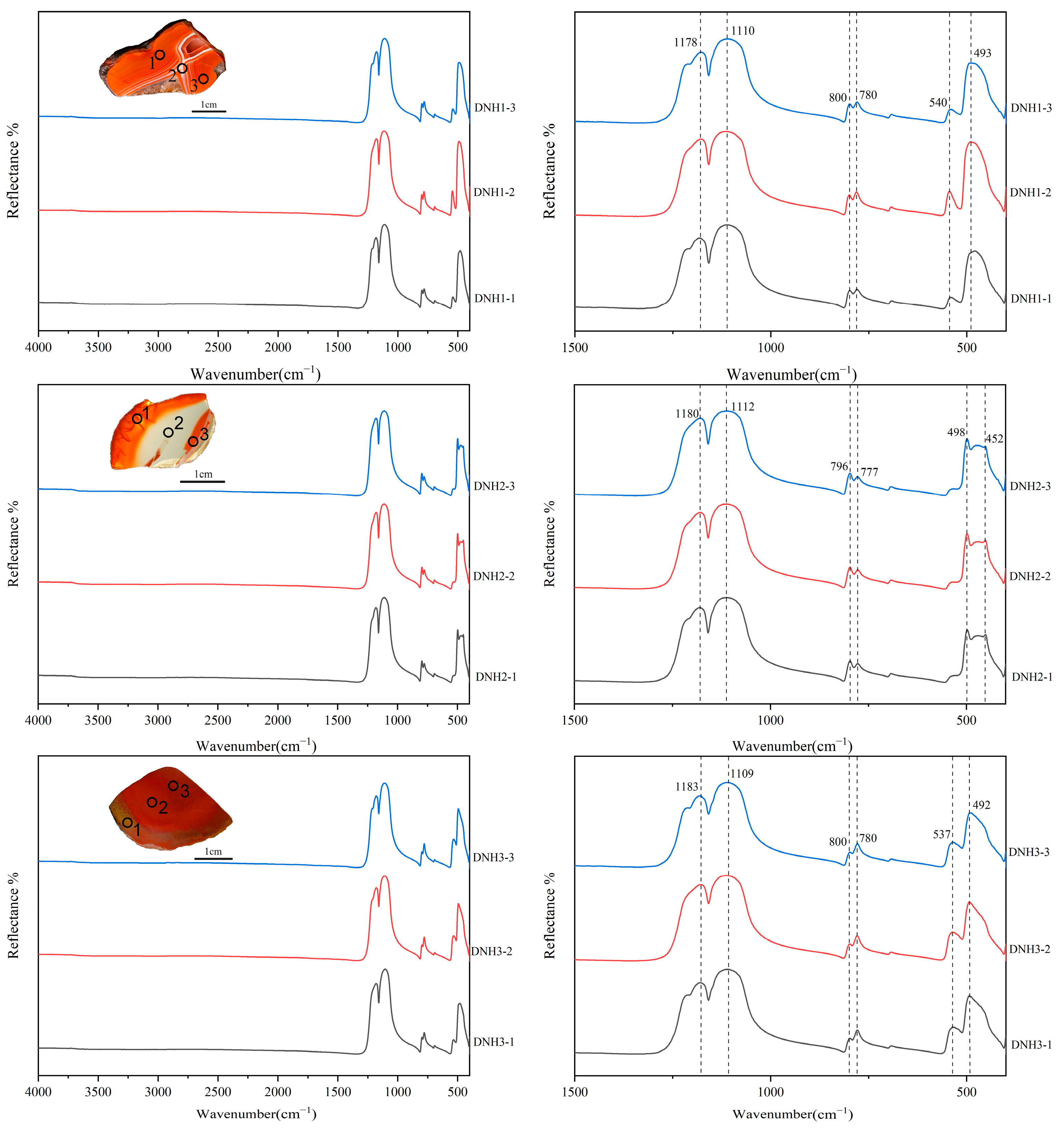
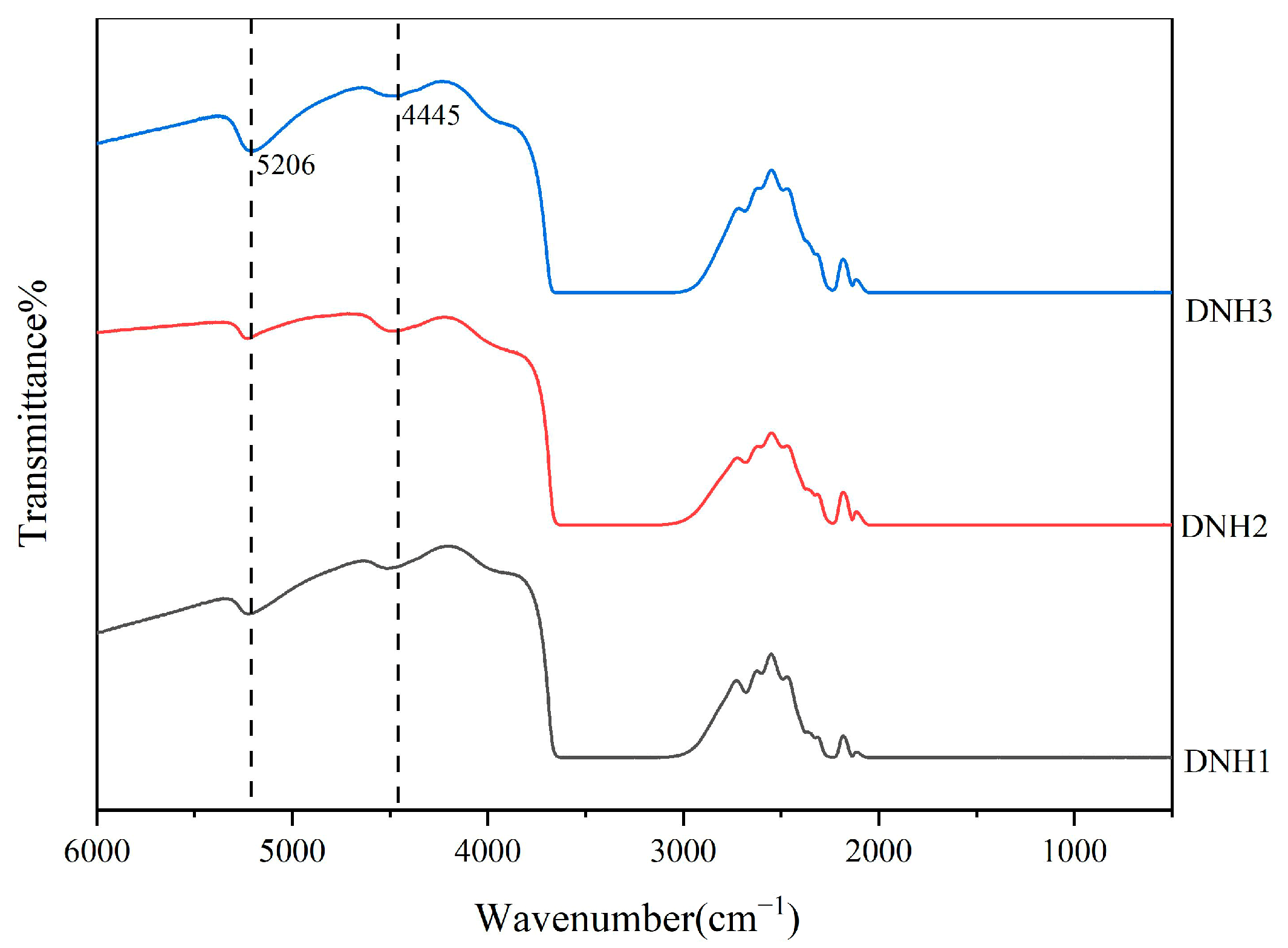
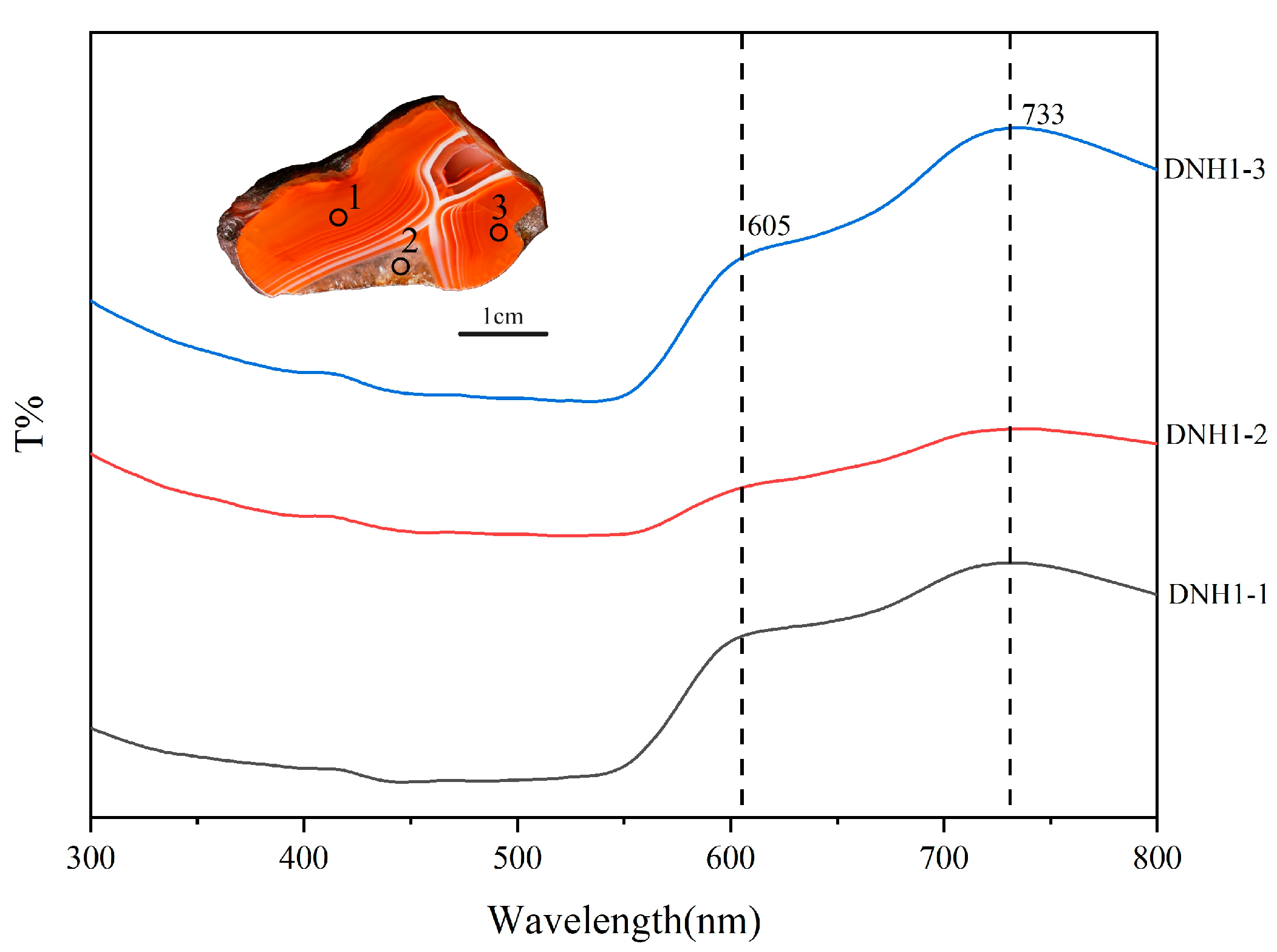
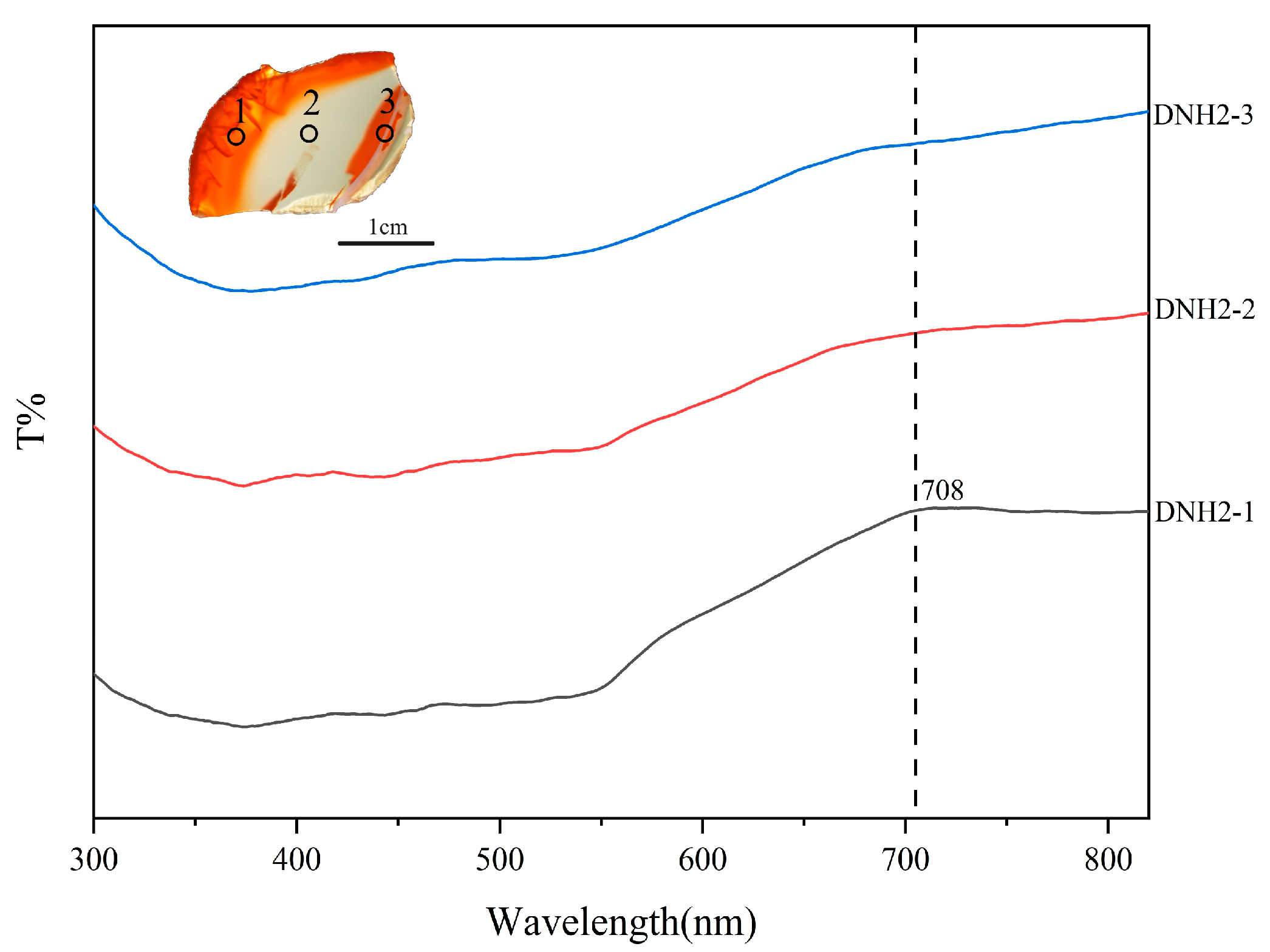


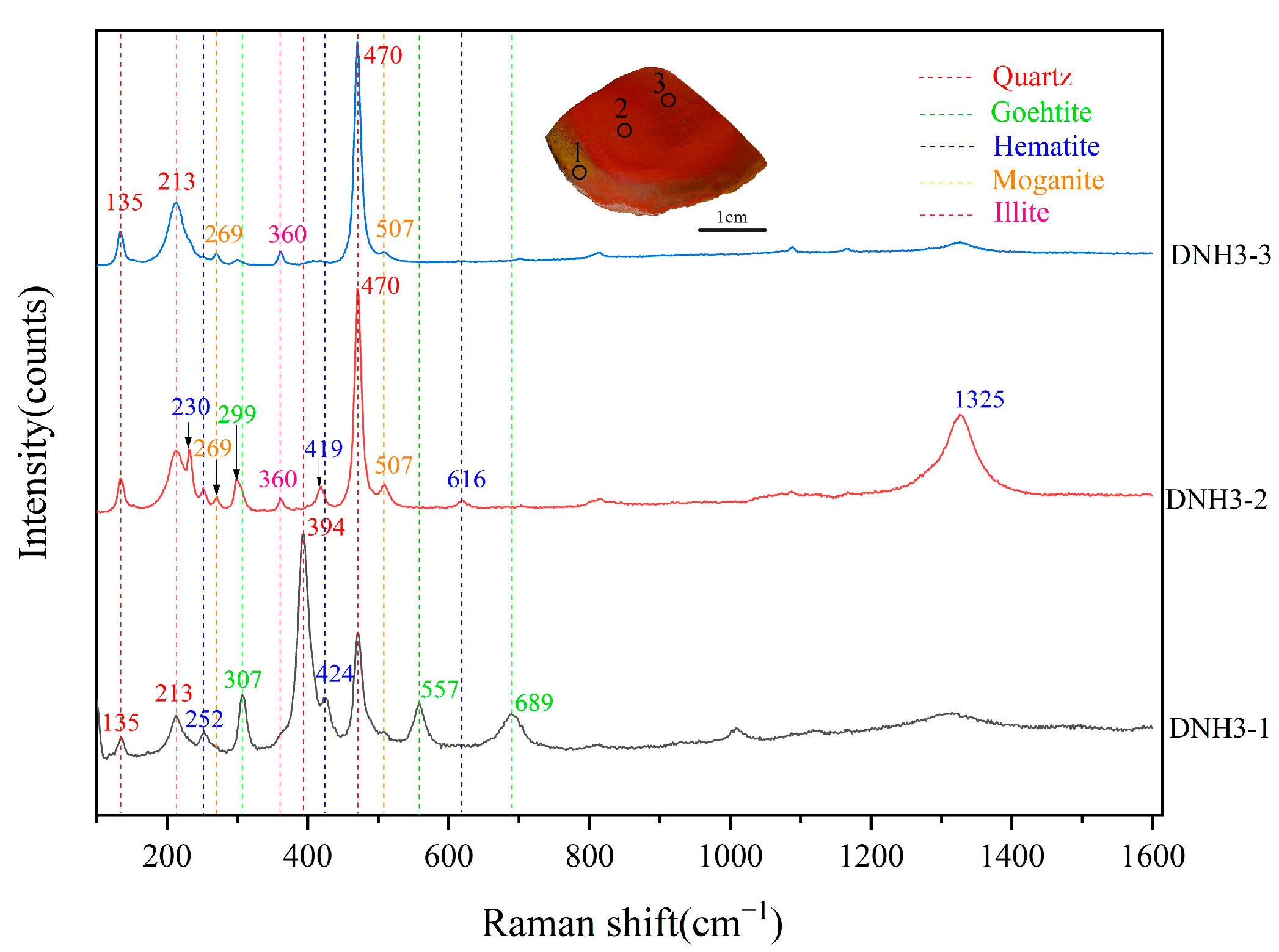
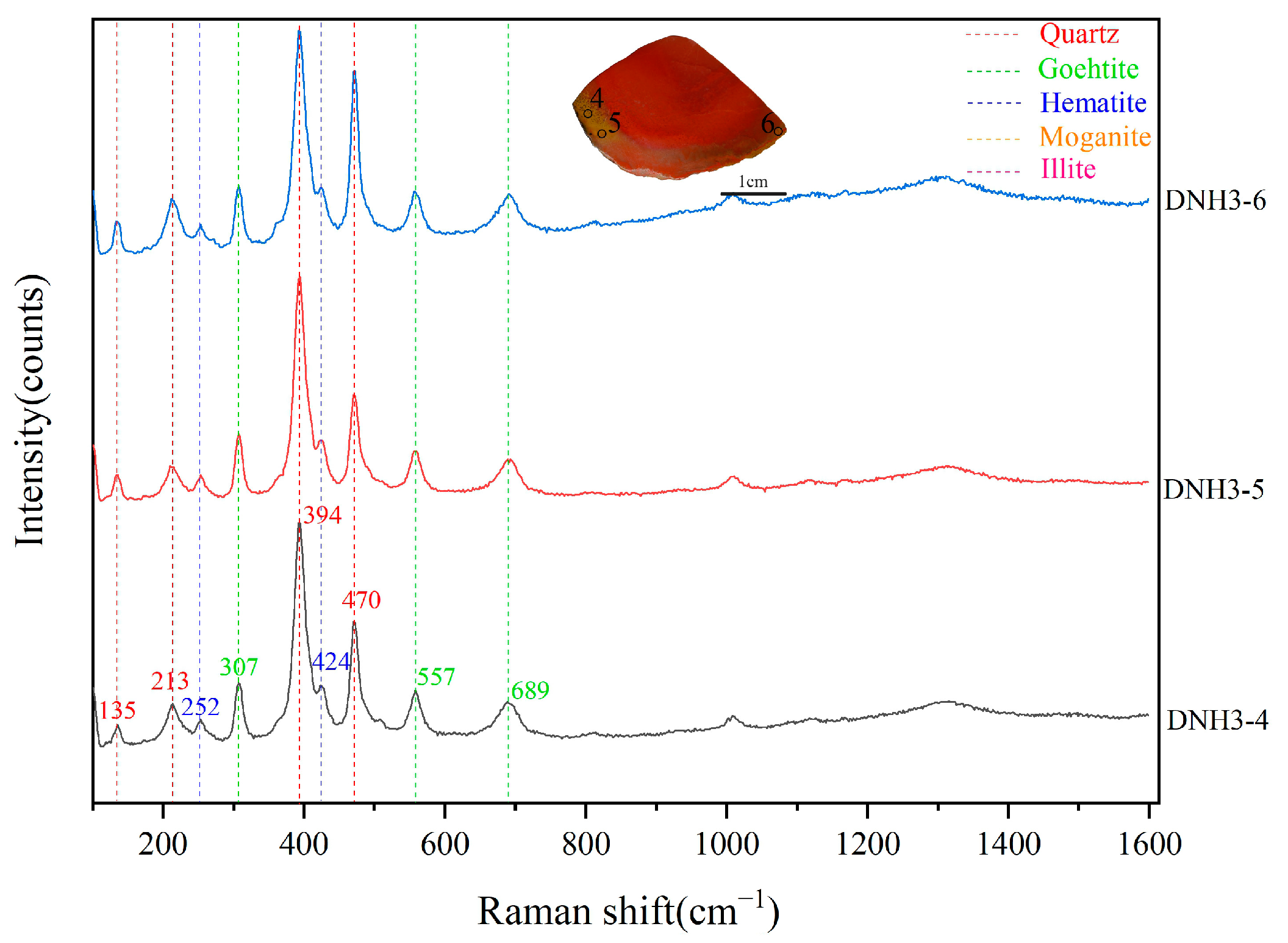
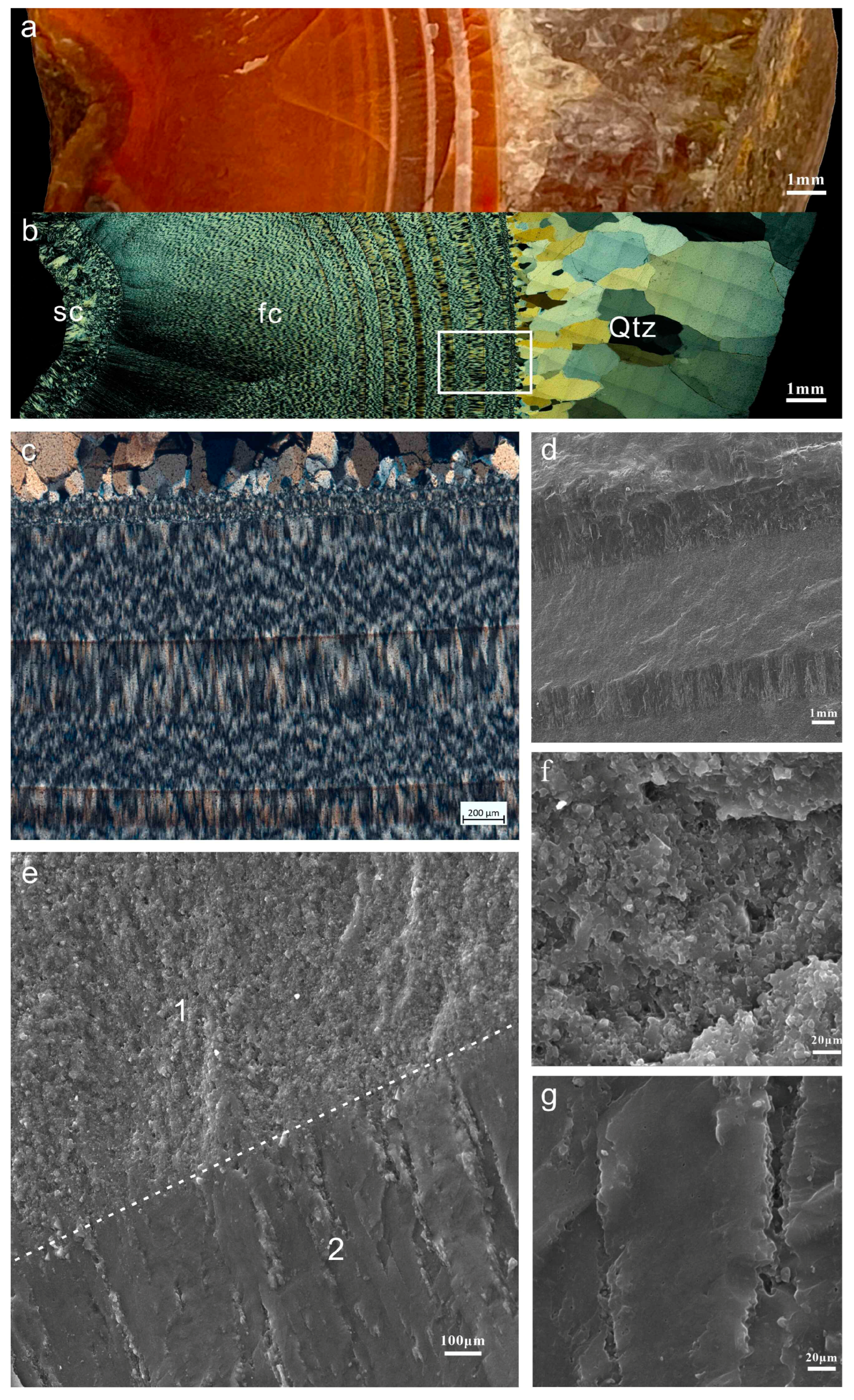
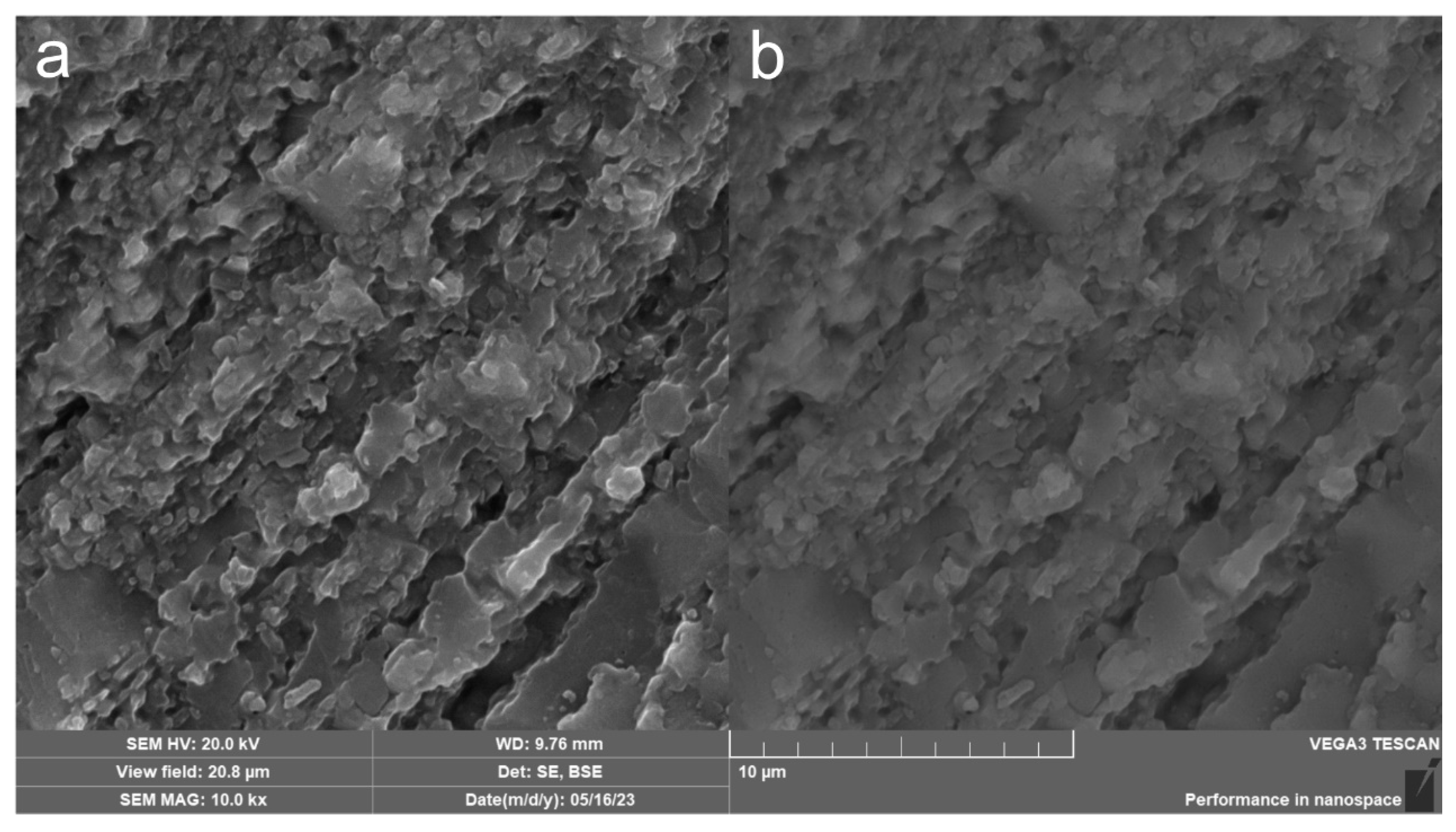
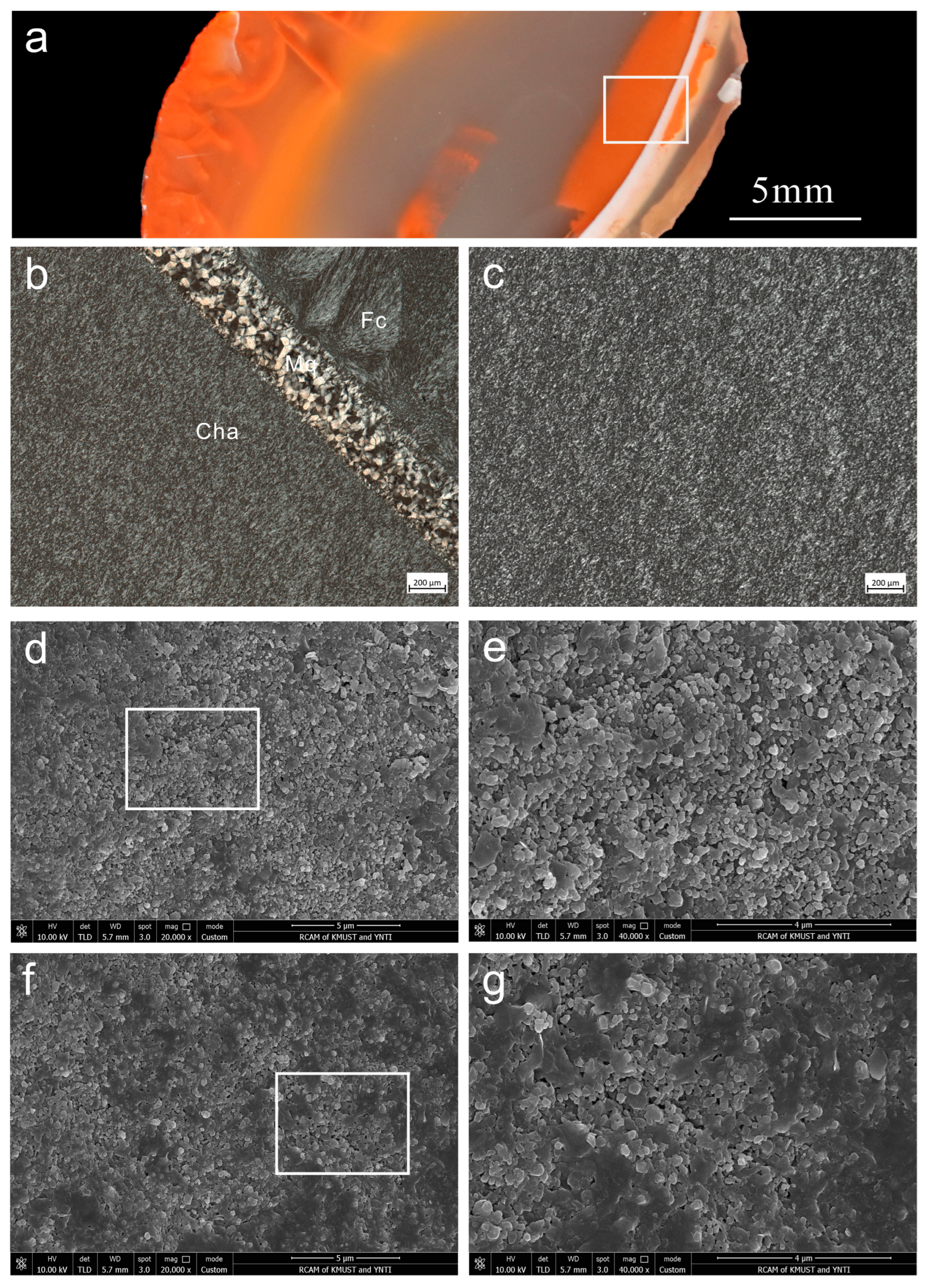
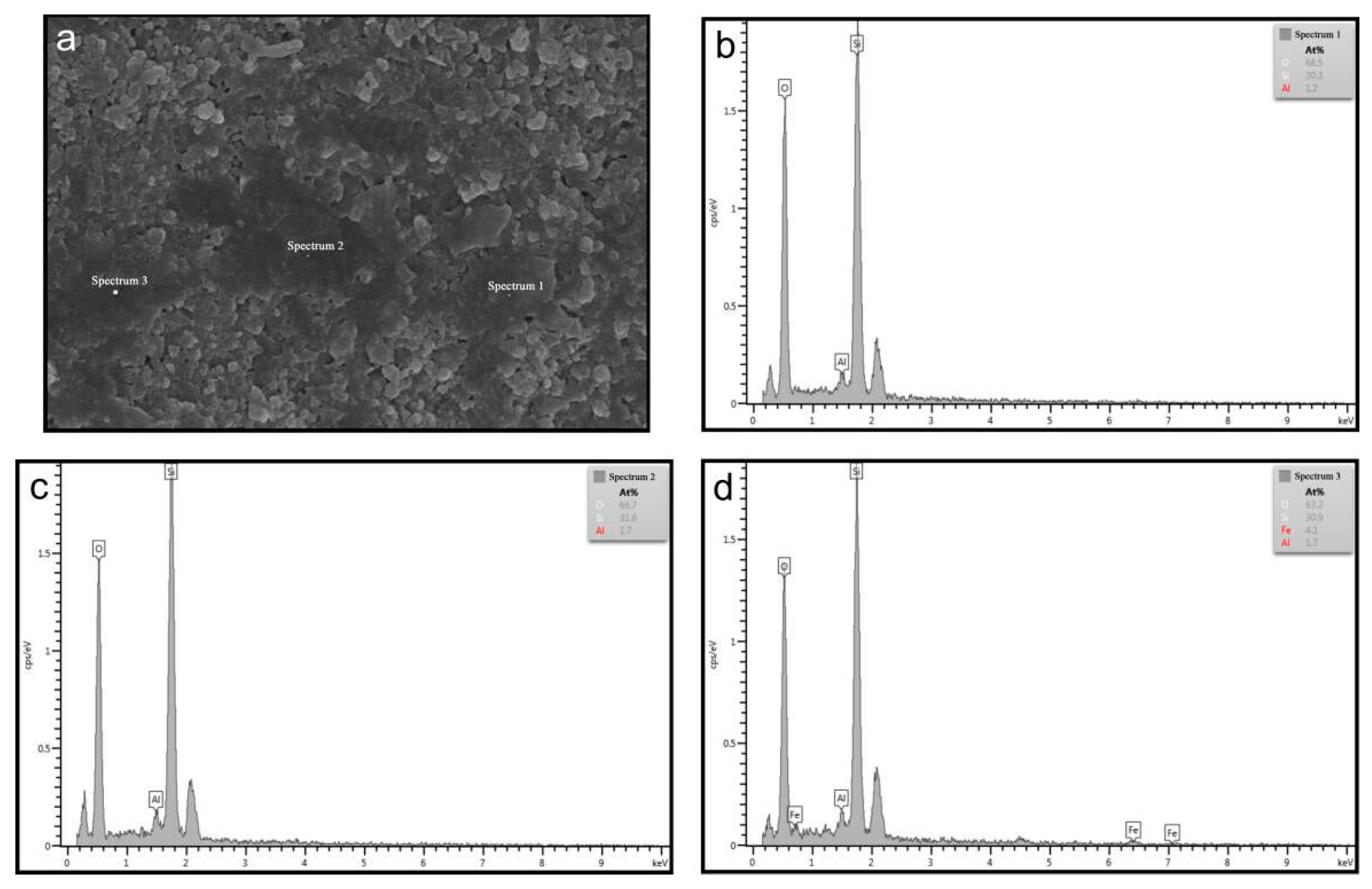

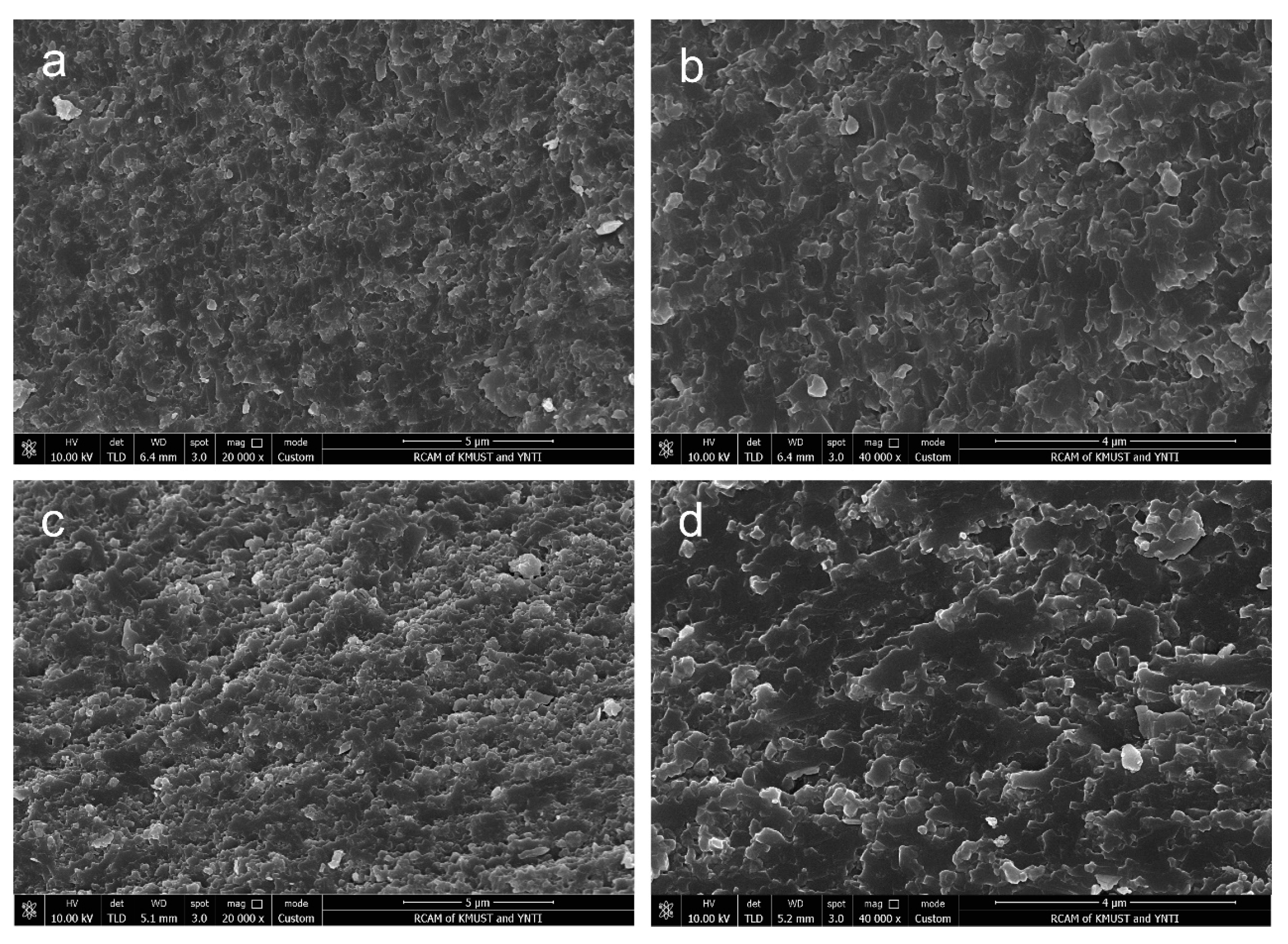
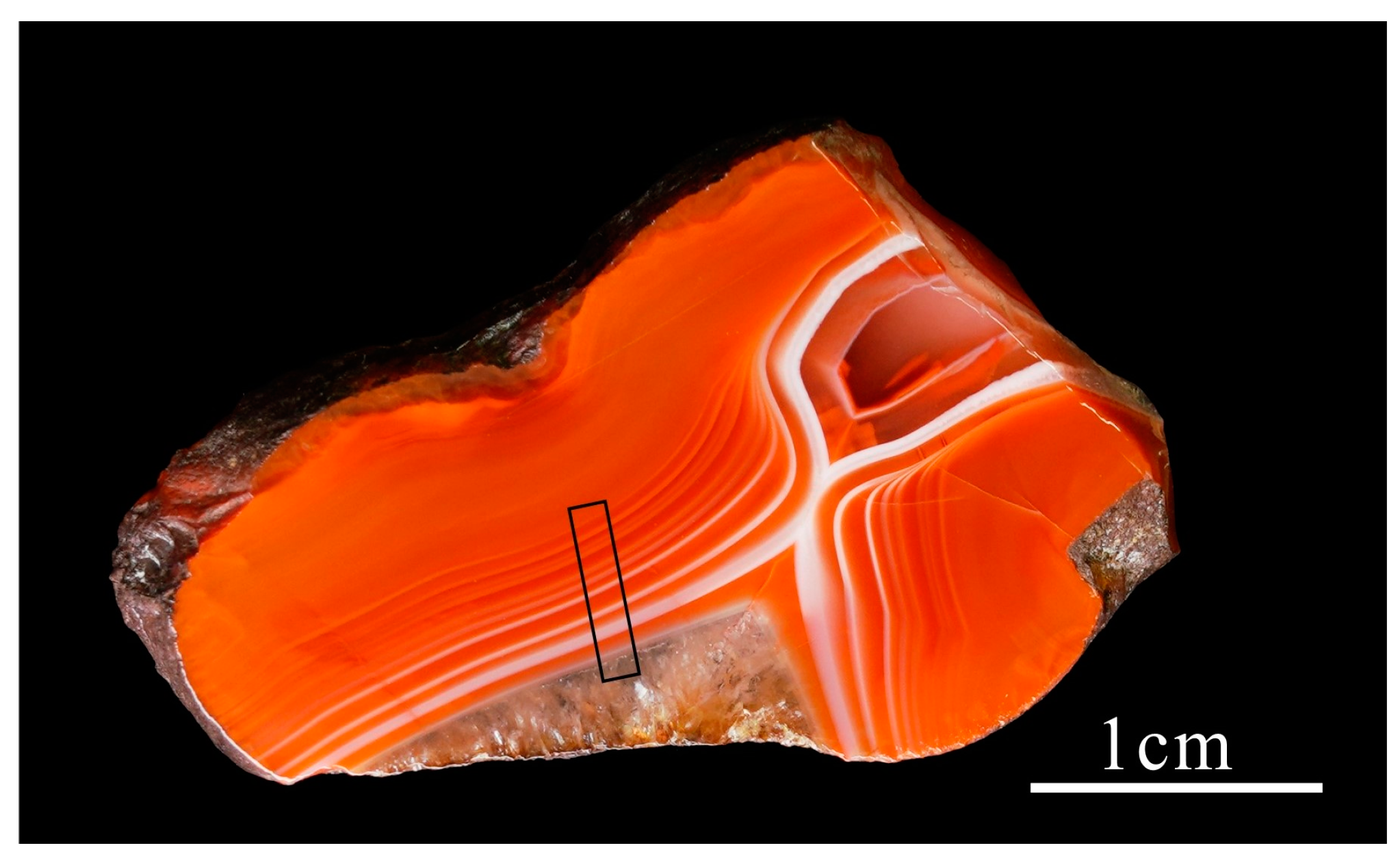

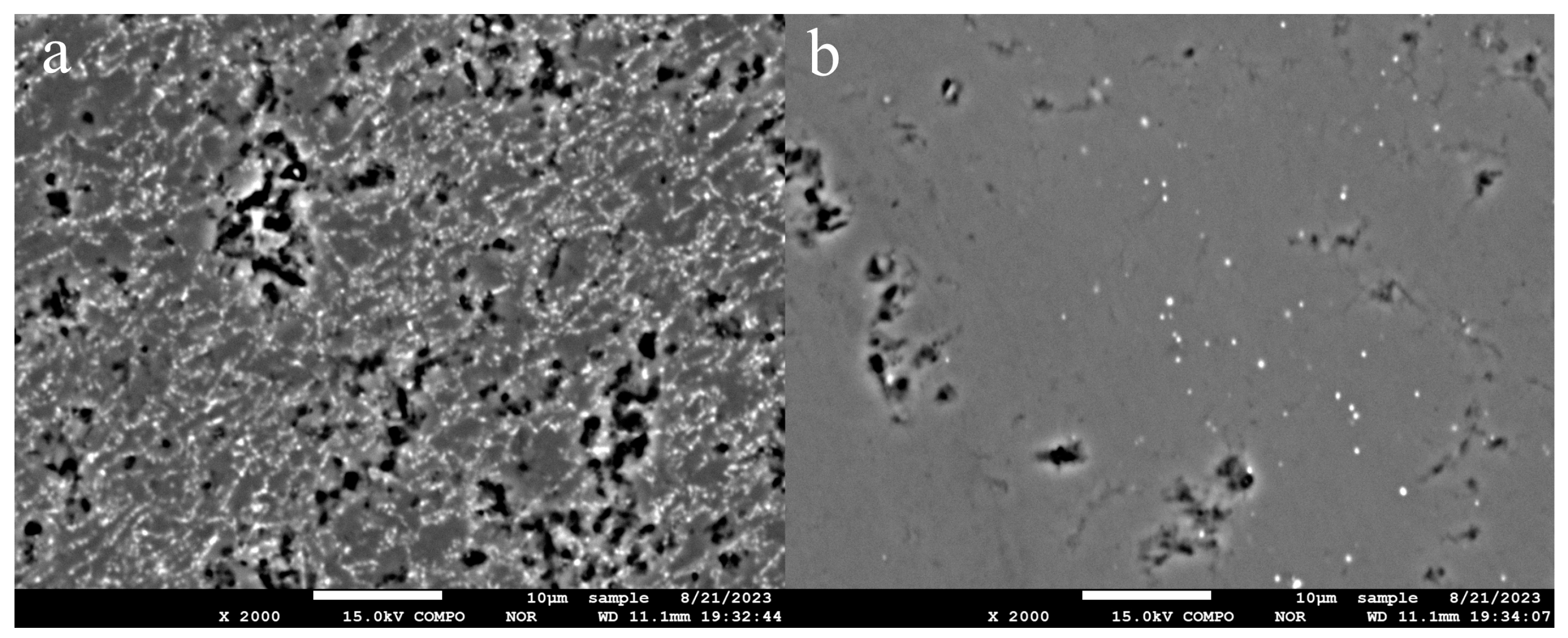
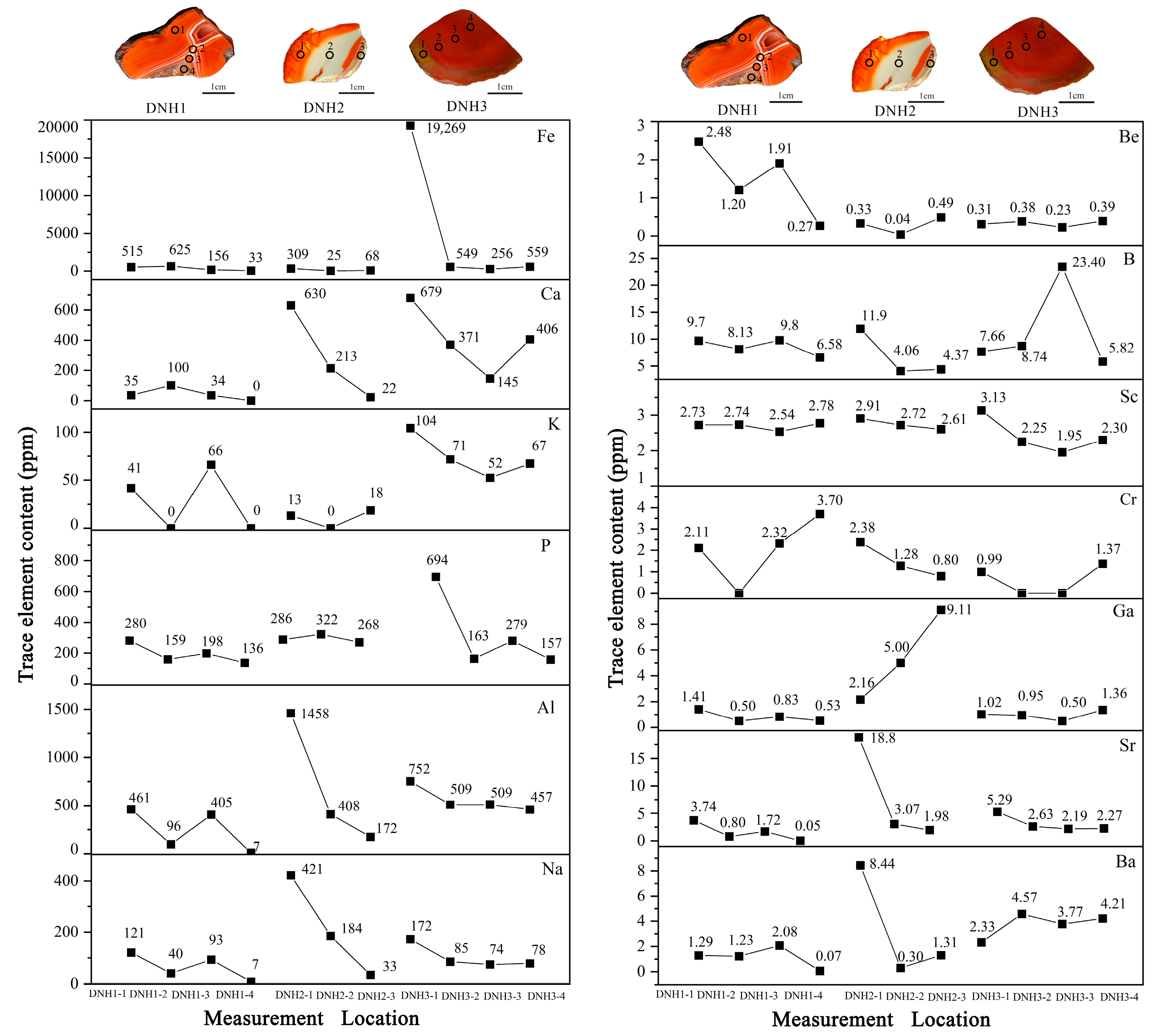
| Sample Point | O | Si | Al | Fe |
|---|---|---|---|---|
| Point 1 | 68.5 | 30.3 | 1.2 | |
| Point 2 | 66.7 | 31.6 | 1.7 | |
| Point 3 | 63.2 | 30.9 | 1.7 | 4.1 |
| Sample Number | DNH2-01 | DNH2-02 | DNH3-01 | DNH3-02 |
|---|---|---|---|---|
| SiO2 | 100.02 | 100.05 | 93.81 | 99.13 |
| TiO2 | 0.00 | 0.00 | 0.05 | 0.00 |
| Al2O3 | 0.06 | 0.03 | 0.13 | 0.07 |
| FeO | 0.01 | 0.00 | 5.20 | 1.44 |
| MnO | 0.00 | 0.00 | 0.01 | 0.00 |
| MgO | 0.00 | 0.00 | 0.00 | 0.01 |
| CaO | 0.02 | 0.02 | 0.04 | 0.02 |
| Na2O | 0.02 | 0.03 | 0.00 | 0.00 |
| K2O | 0.01 | 0.00 | 0.01 | 0.01 |
| P2O5 | 0.00 | 0.00 | 0.10 | 0.02 |
| UO2 | 0.01 | 0.00 | 0.00 | 0.00 |
| SO3 | 0.00 | 0.00 | 0.00 | 0.00 |
| Total | 100.16 | 100.13 | 99.34 | 100.69 |
Disclaimer/Publisher’s Note: The statements, opinions and data contained in all publications are solely those of the individual author(s) and contributor(s) and not of MDPI and/or the editor(s). MDPI and/or the editor(s) disclaim responsibility for any injury to people or property resulting from any ideas, methods, instructions or products referred to in the content. |
© 2024 by the authors. Licensee MDPI, Basel, Switzerland. This article is an open access article distributed under the terms and conditions of the Creative Commons Attribution (CC BY) license (https://creativecommons.org/licenses/by/4.0/).
Share and Cite
Song, Q.; Chen, L.; Zuo, R.; Chen, X.; Sui, S.; Pu, W.; Yang, X.; Zhang, S.; Liu, W. Origin of Color and Spectral Characteristics of Nanhong Agate from Northeast Yunnan, China. Crystals 2024, 14, 388. https://doi.org/10.3390/cryst14040388
Song Q, Chen L, Zuo R, Chen X, Sui S, Pu W, Yang X, Zhang S, Liu W. Origin of Color and Spectral Characteristics of Nanhong Agate from Northeast Yunnan, China. Crystals. 2024; 14(4):388. https://doi.org/10.3390/cryst14040388
Chicago/Turabian StyleSong, Qiuyun, Liurunxuan Chen, Ruohan Zuo, Xianchao Chen, Sugang Sui, Wenzhou Pu, Xiaoqi Yang, Shitao Zhang, and Wenlian Liu. 2024. "Origin of Color and Spectral Characteristics of Nanhong Agate from Northeast Yunnan, China" Crystals 14, no. 4: 388. https://doi.org/10.3390/cryst14040388




